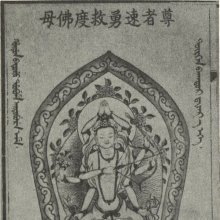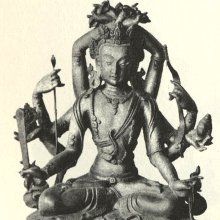Pravira, Pravīra: 16 definitions
Introduction:
Pravira means something in Buddhism, Pali, Hinduism, Sanskrit, Jainism, Prakrit, the history of ancient India. If you want to know the exact meaning, history, etymology or English translation of this term then check out the descriptions on this page. Add your comment or reference to a book if you want to contribute to this summary article.
Images (photo gallery)
In Hinduism
Purana and Itihasa (epic history)
Source: Wisdom Library: Bhagavata PuranaPravīra (प्रवीर):—Son of Pracinvān (son of King Janamejaya, who was born into the Pūru dynasty). He had a son called Manusyu. (see Bhāgavata Purāṇa 9.20.2)
Source: archive.org: Puranic Encyclopedia1) Pravīra (प्रवीर).—A king of the Pūru dynasty. His father was Santurodha. He had two brothers named Duṣyanta and Sumanta. (Chapter 278, Agni Purāṇa).
2) Pravīra (प्रवीर).—A son of Pūru, a king of the Pūru dynasty His mother was Pauṣṭī. He had two brothers named Īśvara and Raudrāśva. Pravīra got of his wife Śūrasenī a son named Manasyu. He was known by the name Janamejaya also. After conducting three aśvamedhas, Pravīra accepted Vānaprastha (third stage of life). (Śloka 11, Chapter 95, Ādi Parva).
3) Pravīra (प्रवीर).—A special class of Kṣatriyas. King Vṛṣadhvaja was born in this class. (Śloka 16, Chapter 74, Udyoga Parva).
4) Pravīra (प्रवीर).—A caṇḍāla (the lowest and most despised of all classes of people). In order to keep his word of honour Hariścandra allowed himself to be sold to this caṇḍāla Pravīra. He was none other than Lord Śiva himself. (See under Hariścandra).
Source: Cologne Digital Sanskrit Dictionaries: The Purana Index1a) Pravīra (प्रवीर).—A son of Prācīnavat, and father of Namasyu (Manasyu Viṣṇu-purāṇa).*
- * Bhāgavata-purāṇa IX. 20. 2; Viṣṇu-purāṇa IV. 19. 1.
1b) A son of Vindhyaśakti and a great hero: capital at Kāncanaka: performed the Vājapeya and other yajñas, father of four sons: ruled for 6 years.*
- * Brahmāṇḍa-purāṇa III. 74. 184-6; Vāyu-purāṇa 99. 371-2.
1c) A son of Upadānavī.*
- * Matsya-purāṇa 49. 10.
1d) A son of Trasyu.*
- * Vāyu-purāṇa 99. 133.
1e) A king of the dynasty of Vindhyaśakti.*
- * Viṣṇu-purāṇa IV. 24. 56.
Pravīra (प्रवीर) is a name mentioned in the Mahābhārata (cf. I.89.5) and represents one of the many proper names used for people and places. Note: The Mahābhārata (mentioning Pravīra) is a Sanskrit epic poem consisting of 100,000 ślokas (metrical verses) and is over 2000 years old.

The Purana (पुराण, purāṇas) refers to Sanskrit literature preserving ancient India’s vast cultural history, including historical legends, religious ceremonies, various arts and sciences. The eighteen mahapuranas total over 400,000 shlokas (metrical couplets) and date to at least several centuries BCE.
In Buddhism
Tibetan Buddhism (Vajrayana or tantric Buddhism)
Source: Rangjung Yeshe Wiki: Dharma DictionaryPravīra (प्रवीर) or Pravīratārā (in Tibetan: རབ་ཏུ་དཔའ་བའི་སྒྲོལ་མ) refers to the “swift and heroic Tārā” and represents one of the twenty-one emanations of Tārā according to the Kashmiri Mahasiddha Suryagupta Tradition.—Suryagupta or Ravigupta (Tibetan: nyi ma be pa) was a layperson from Kashmir that was cured of leprosy by a miraculous statue of the goddess Tara. Suryagupta is famous for having many visions of Tara and originating many lineages of her practice such as the Twenty-one forms of Tara [e.g., Pravīra-tārā]. There exists inscriptions and paintings (from the 14th century) of these Twenty-one Taras and they are also described in ritual and meditation texts in both Sanskrit and Tibetan language.

Tibetan Buddhism includes schools such as Nyingma, Kadampa, Kagyu and Gelug. Their primary canon of literature is divided in two broad categories: The Kangyur, which consists of Buddha’s words, and the Tengyur, which includes commentaries from various sources. Esotericism and tantra techniques (vajrayāna) are collected indepently.
In Jainism
General definition (in Jainism)
Source: The University of Sydney: A study of the Twelve ReflectionsPravīra (प्रवीर) refers to “heroes”, according to the 11th century Jñānārṇava, a treatise on Jain Yoga in roughly 2200 Sanskrit verses composed by Śubhacandra.—Accordingly, “This world totters to the limit of the world of Brahmā with the fear of the beginning of a frown, and mountains immediately fall asunder by force of [the fact that] the earth is overcome by the weight of the heavy feet, of those heroes (pravīra) who are all led to death by the king of time in [the space of] some days. Nevertheless, desire is intense only in a living being who is bereft of sense”.

Jainism is an Indian religion of Dharma whose doctrine revolves around harmlessness (ahimsa) towards every living being. The two major branches (Digambara and Svetambara) of Jainism stimulate self-control (or, shramana, ‘self-reliance’) and spiritual development through a path of peace for the soul to progess to the ultimate goal.
India history and geography
Source: Shodhganga: Ajanta’s antiquityPravira (r. 250-275 CE) or Pravaraṣeṇa I is a king from the Vākāṭaka dynasty of ancient India. During the rule of the Vākāṭakas (founded by Vindhyaśakti), there was a burst of patronage and creative energy directed at the Ajantā caves at West-Khandesh (West-Khaṇḍeśa, modern Jalgaon) that existed since the 3rd century BCE. During this time the region was ruled by kings (e.g., Pravira) and descendants of the Sātavāhana lineage. After, Pravira the Vākāṭaka dynasty split into two factions: The Nandivardhana branch (or the Eastern Vākāṭakas), founded by Rudraṣeṇa I (son of Gautamiputra I), and the Vatsagulma branch (or the Western Vākāṭakas), founded by Sarvaṣeṇa I (ca. 325–355 CE).

The history of India traces the identification of countries, villages, towns and other regions of India, as well as mythology, zoology, royal dynasties, rulers, tribes, local festivities and traditions and regional languages. Ancient India enjoyed religious freedom and encourages the path of Dharma, a concept common to Buddhism, Hinduism, and Jainism.
Languages of India and abroad
Sanskrit dictionary
Source: DDSA: The practical Sanskrit-English dictionaryPravira (प्रविर).—Yellow sandal.
Derivable forms: praviraḥ (प्रविरः).
--- OR ---
Pravīra (प्रवीर).—a.
1) Foremost, best, most excellent or distinguished; तस्यै प्रतिश्रुत्य रघुप्रवीरः (tasyai pratiśrutya raghupravīraḥ) R.14.29;16.1; कुरुप्रवीर (kurupravīra) Bhagavadgītā (Bombay) 11.48.
2) Strong, powerful, heroic; प्रवीरे वास्तुनि राजनिवेशाः (pravīre vāstuni rājaniveśāḥ) Kau. A.2.4.
-raḥ 1 A brave person, hero, warrior; प्रक्षपितप्रवीरम् (prakṣapitapravīram) ...... जर्जरमकुर्वन् (jarjaramakurvan) Daśakumāracarita 2.8.
2) A chief, distinguished personage.
Source: Cologne Digital Sanskrit Dictionaries: Shabda-Sagara Sanskrit-English DictionaryPravira (प्रविर).—m.
(-raḥ) A yellow fragrant wood. E. pra and vi before, rā to get or be, aff. ḍa .
--- OR ---
Pravīra (प्रवीर).—mfn.
(-raḥ-rā-raṃ) Best, most excellent. m.
(-raḥ) 1. A hero, a warrior. 2. A chief, a person of rank or distinction. 3. Strong, powerful. E. pra pre-eminent, and vīra a hero.
Source: Cologne Digital Sanskrit Dictionaries: Benfey Sanskrit-English DictionaryPravīra (प्रवीर).—[pra-vīra], I. adj. Excellent, bravest, [Hitopadeśa] iii. [distich] 70. Ii. m. 1. A hero, [Uttara Rāmacarita, 2. ed. Calc., 1862.] 122, 4. 2. A chief, [Rāmāyaṇa] 3, 49, 57.
Source: Cologne Digital Sanskrit Dictionaries: Cappeller Sanskrit-English DictionaryPravīra (प्रवीर).—[masculine] great hero, chief among ([genetive] or —°).
Source: Cologne Digital Sanskrit Dictionaries: Monier-Williams Sanskrit-English Dictionary1) Pravira (प्रविर):—m. yellow sandal, [cf. Lexicographers, esp. such as amarasiṃha, halāyudha, hemacandra, etc.]
2) Pravīra (प्रवीर):—[=pra-vīra] mfn. preceding or surpassing heroes, [Ṛg-veda x, 103, 5] (cf. abhi-vīra)
3) [v.s. ...] m. a hero, prince, chief among ([genitive case] or [compound]), a person excellent or distinguished by ([compound]), [Mahābhārata; Kāvya literature] etc. (ifc. f(ā). )
4) [v.s. ...] m. Name of a son of Pūru, [Mahābhārata]
5) [v.s. ...] of a son of Pracinvat (grandson of Pūru), [Harivaṃśa; Purāṇa]
6) [v.s. ...] of a son of Dharmanetra, [Harivaṃśa]
7) [v.s. ...] of a son of Hary-aśva, [Viṣṇu-purāṇa]
8) [v.s. ...] of a son of the 14th Manu, [Harivaṃśa] ([varia lectio] pra-vīṇa)
9) [v.s. ...] of a Caṇḍāla, [Mārkaṇḍeya-purāṇa]
10) [v.s. ...] [plural] Name of the descendants of Pravīra (son of Pūru), [Mahābhārata]
Source: Cologne Digital Sanskrit Dictionaries: Yates Sanskrit-English Dictionary1) Pravira (प्रविर):—[pra-vira] (raḥ) 1. m. A fragrant wood.
2) Pravīra (प्रवीर):—[pra-vīra] (raḥ-rā-raṃ) a. Best, paramount. m. A hero, a chief.
[Sanskrit to German]
Sanskrit, also spelled संस्कृतम् (saṃskṛtam), is an ancient language of India commonly seen as the grandmother of the Indo-European language family (even English!). Closely allied with Prakrit and Pali, Sanskrit is more exhaustive in both grammar and terms and has the most extensive collection of literature in the world, greatly surpassing its sister-languages Greek and Latin.
Kannada-English dictionary
Source: Alar: Kannada-English corpusPravīra (ಪ್ರವೀರ):—[adjective] having or showing valour; courageous; brave; valorous.
--- OR ---
Pravīra (ಪ್ರವೀರ):—
1) [noun] a brave, valorous man.
2) [noun] an excellent, meritorious man.
Kannada is a Dravidian language (as opposed to the Indo-European language family) mainly spoken in the southwestern region of India.
See also (Relevant definitions)
Starts with: Pravirabahu, Pravirajate, Praviraka, Pravirala, Praviralamani, Pravirapurusha, Pravirata, Praviratara, Praviravara.
Ends with: Hatapravira, Shinipravira, Surapravira, Vipravira.
Full-text (+37): Namasyu, Manasyu, Pravina, Pracinvan, Pravirabahu, Praviravara, Pravirapurusha, Praviraka, Shuraseni, Kamjanaka, Kancanaka, Surapravira, Shankamana, Prativira, Carupada, Hatapravira, Gabhira, Shinipravira, Manusyu, Vrishadhvaja.
Relevant text
Search found 16 books and stories containing Pravira, Pra-vira, Pra-vīra, Pravīra; (plurals include: Praviras, viras, vīras, Pravīras). You can also click to the full overview containing English textual excerpts. Below are direct links for the most relevant articles:
Rig Veda (translation and commentary) (by H. H. Wilson)
Puranic encyclopaedia (by Vettam Mani)
Mahabharata (English) (by Kisari Mohan Ganguli)
Shrimad Bhagavad-gita (by Narayana Gosvami)
Verse 11.48 < [Chapter 11 - Viśvarūpa-darśana-yoga (beholding the Lord’s Universal Form)]
List of Mahabharata people and places (by Laxman Burdak)
The Matsya Purana (critical study) (by Kushal Kalita)
Part 2.1m - The Paurava Dynasty < [Chapter 3 - Historical aspects in the Matsyapurāṇa]
Related products

